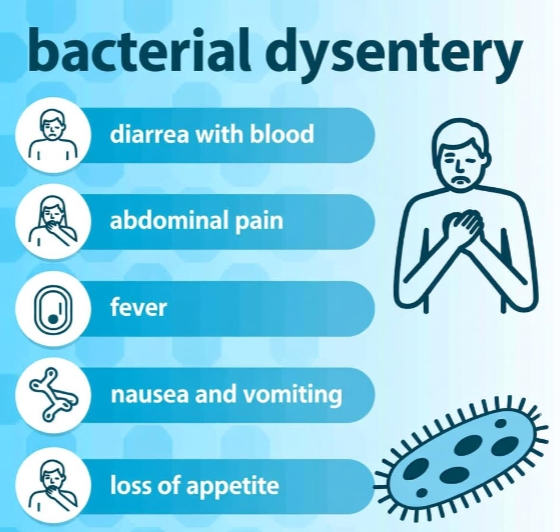Bacterial dysentery is an acute invasive infection of the colon caused by Shigella, enteroinvasive or enterohemorrhagic Escherichia coli, Campylobacter, Salmonella enterica serovar Typhi or Paratyphi, and occasionally Yersinia. The hallmark is frequent, small-volume stools containing blood, mucus, or pus, accompanied by systemic toxicity. Rapid recognition guides stool testing, appropriate antibiotics, and prevention of secondary spread.
- Core intestinal features
• Tenesmus: painful, ineffectual straining with a constant urge to defecate; patients may visit the toilet dozens of times daily.
• Frequent scant stools: 8–20 passages per 24 h, each <100 g, often consisting only of blood-streaked mucus.
• Gross blood and pus: bright-red blood mixed with stringy mucus or visible pus flakes; color darkens when transit is slower.
• Cramping lower-abdominal pain: suprapubic or left-lower-quadrant, relieved transiently after each passage.
• Urgency and fecal incontinence: inability to delay defecation more than a few minutes, especially in children. - Systemic and toxic signs
• High fever >38.5 °C, often exceeding 39 °C within 24 h of onset.
• Malaise, headache, anorexia; vomiting is less prominent than in viral gastroenteritis.
• Tachycardia and postural dizziness correlate with dehydration and systemic inflammation.
• In severe Shigella infection (shigellosis): seizures in toddlers, altered consciousness, or hypotension indicating toxic megacolon. - Variant presentations by pathogen
• Shigella: shortest incubation (1–3 days), highest fever, most intense tenesmus; white blood cell casts in stool.
• Campylobacter: prodrome of fever and myalgia, then bloody diarrhea; abdominal pain can mimic acute appendicitis.
• Enterohemorrhagic E. coli: hemorrhagic colitis with little fever, risk of hemolytic-uremic syndrome 5–10 days after onset.
• Salmonella Typhi: relatively less blood, more constitutional symptoms (“typhoid” pattern) with relative bradycardia and hepatosplenomegaly. - Complication flags
Continuous bleeding with orthostatic hypotension, abdominal distension and absent bowel sounds (suggesting megacolon), passage of large clots or melena (implying proximal extension), oliguria or tea-colored urine (microangiopathic hemolysis), and weight loss >5 % within one week.
Summary table
| Symptom complex | Typical pathogens | Warning threshold |
|---|---|---|
| Blood-streaked mucus, high fever | Shigella | >6 stools/h or seizures → hospitalize |
| Bloody diarrhea, mild fever | EHEC | Oliguria, pallor → check HUS markers |
| Crampy pain, leukocytes in stool | Campylobacter | Localized rebound → exclude appendicitis |
| Constipation followed by bloody stool | Salmonella Typhi | Rose spots, hepatomegaly → blood cultures |
| Persistent tenesmus, no improvement | Any | Day 3 still febrile → consider antibiotic switch |
